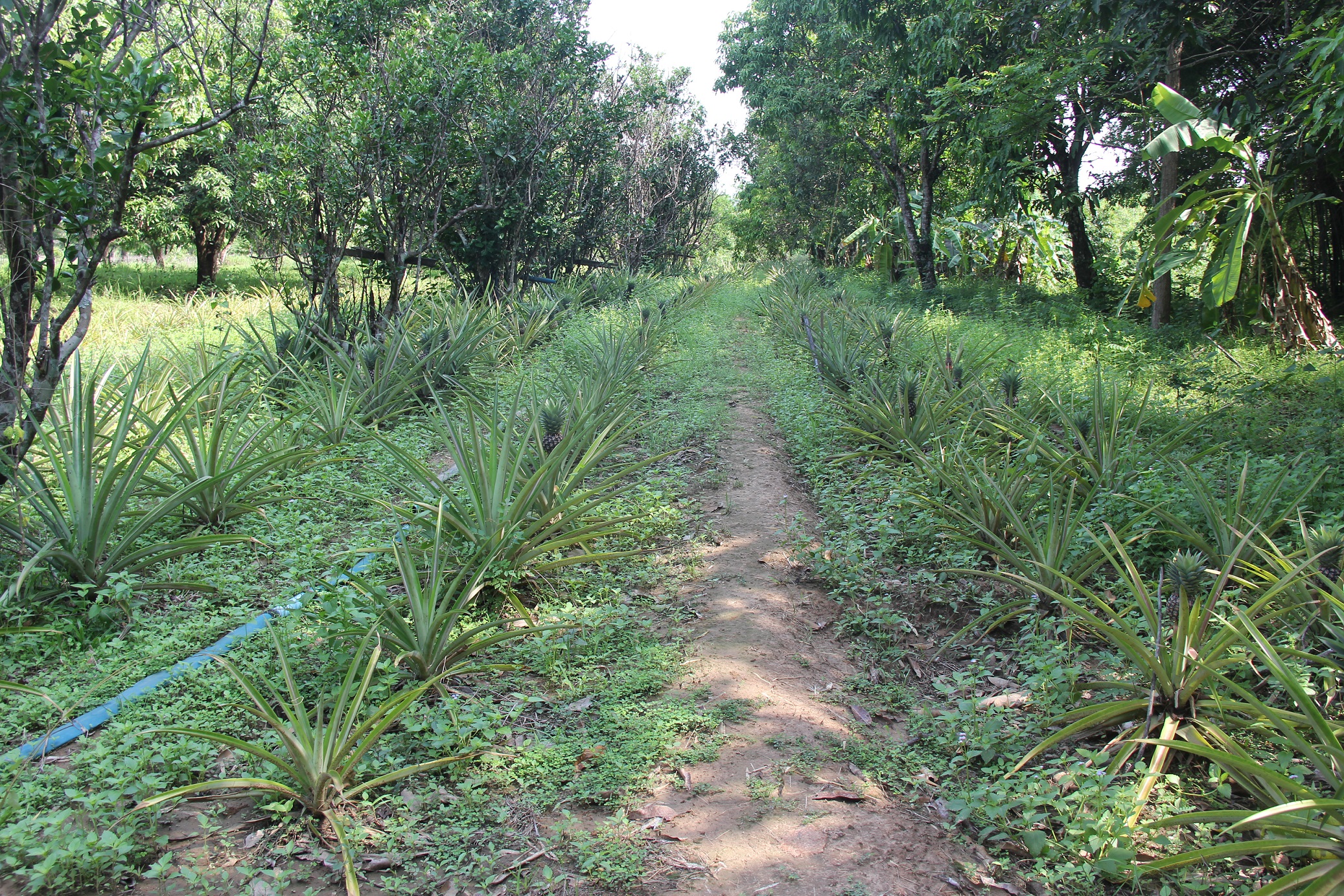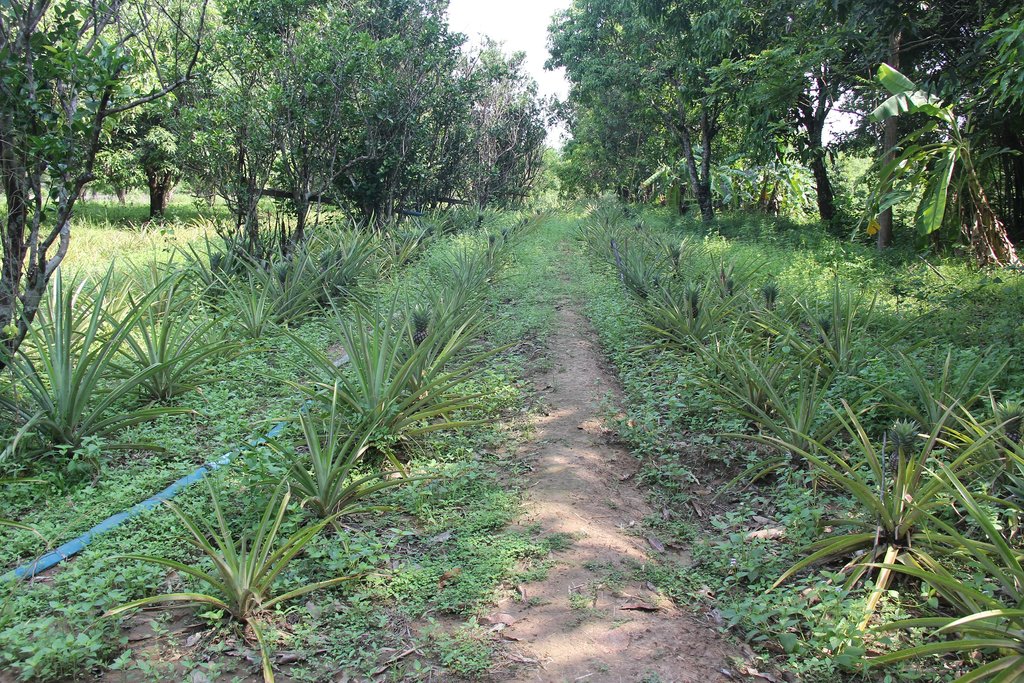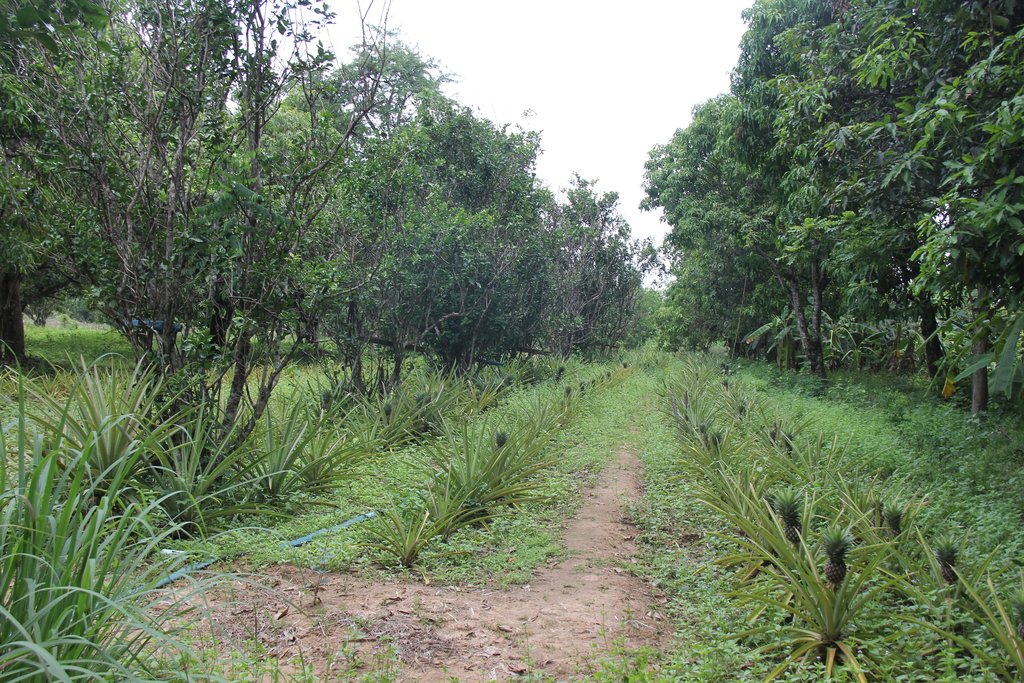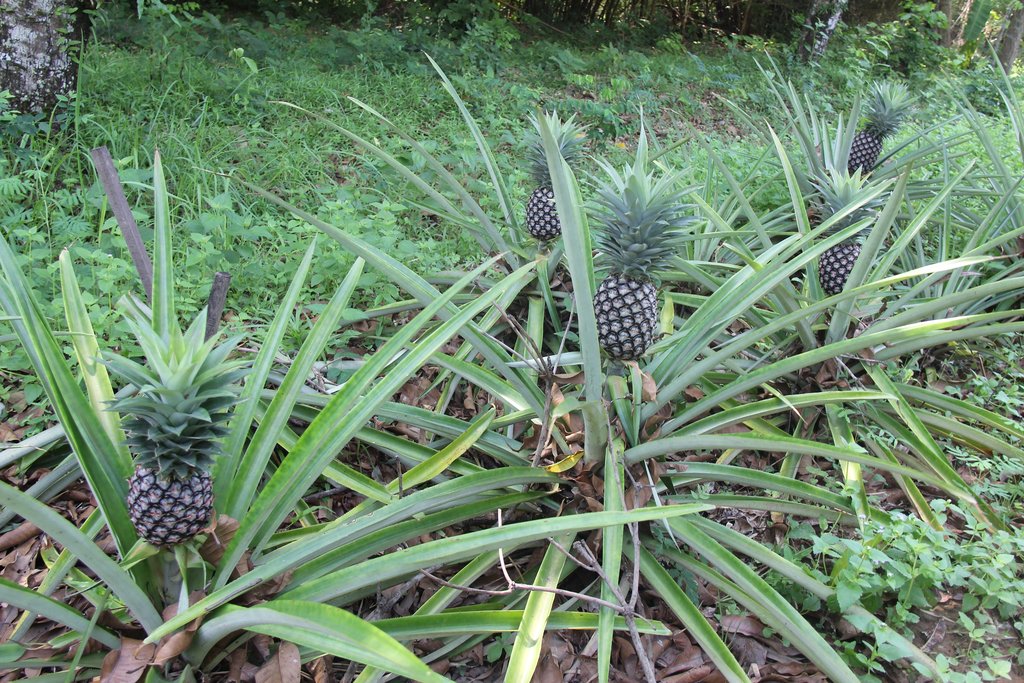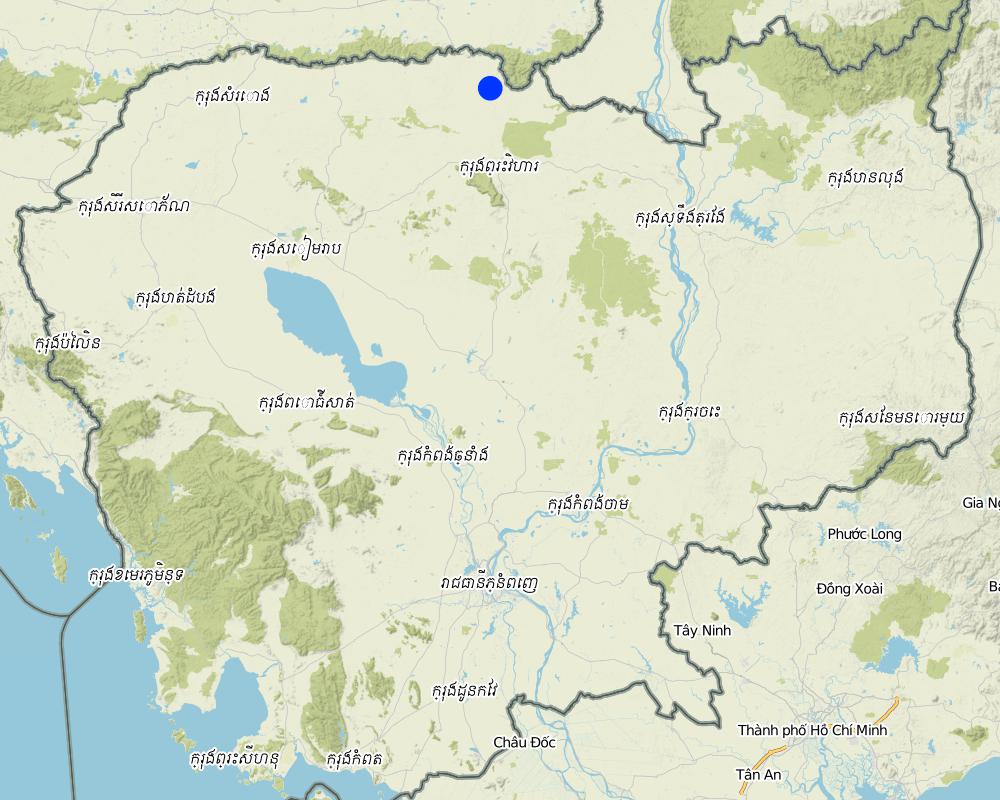Agroforestry: intercropping of pineapple between orange and mango trees [Cambodia]
- Creation:
- Update:
- Compiler: Be Gechkim
- Editors: Sophea Tim, Navin Chea
- Reviewers: Ursula Gaemperli, Stephanie Jaquet, Nicole Harari, SO Than, Alexandra Gavilano
technologies_2843 - Cambodia
View sections
Expand all Collapse all1. General information
1.2 Contact details of resource persons and institutions involved in the assessment and documentation of the Technology
Key resource person(s)
land user:
Dath So
Farmer
Cambodia
Official from District Office of Agriculture, Forestry and Fisheries, Choam Khsant:
Chlat Prach
Office of Agriculture, Forestry and Fisheries, Choam Khsant District
Cambodia
Chief of District Office of Agriculture, Forestry and Fisheries, Kuleaen:
Chief of District Office of Agriculture, Forestry and Fisheries, Rovieng:
Official from Provincial Department of Agriculture, Forestry and Fisheries, Preah Vihear:
1.3 Conditions regarding the use of data documented through WOCAT
The compiler and key resource person(s) accept the conditions regarding the use of data documented through WOCAT:
Yes
1.4 Declaration on sustainability of the described Technology
Is the Technology described here problematic with regard to land degradation, so that it cannot be declared a sustainable land management technology?
No
Comments:
This technique can be classified as agroforestry system, using only natural fertilizers.
2. Description of the SLM Technology
2.1 Short description of the Technology
Definition of the Technology:
The agroforestry practice based on intercropping of pineapple between mango and orange trees helps to maintain soil nutrients while enhancing potential economic benefits through multiple cropping to meet the market demand.
2.2 Detailed description of the Technology
Description:
The increase in forest cover loss has been dramatic, especially in plateau areas due to population growth and agricultural land expansion. The net result is seen in increased soil erosion and decreasing soil fertility, leading to land degradation (MPWT et al., 2016). Thus, agroforestry is being promoted based on its potential benefits through reducing soil erosion, increasing the economic returns, improved crop yields, improved soil fertility, and soil moisture. Agroforestry is the process of planting vegetables or other crops known as annual crops with long-term crops such as mango and orange trees (MoE et al., 2016).
Farmers adopt agro-forestry intercropping as a technique for reducing the application of chemical fertilizers, more economic use of water and soil moisture, higher yields and higher income. Pineapple is a suitable crop for intercropping in the unused space between mango and oranges trees, because it is share tolerant and does not need much sunlight. Pineapple is also resistance to water logging (for up to 7 days). Occasionally, the areas closest to rivers can become flooded for about 24 hours after periods of heavy rain. Often farmers who adopt the practice of intercropping not use chemical fertilizers or pesticide because they rely on the potential benefits of crop residues, leaf material, small plants, and grass cutting. Normally, mango trees and oranges are the long-term crops, and when grown there is usually a large amount of unused spacing in the area where the trees are grown. If this area is not used for other crops, there is weed ingress which can be difficult to control. Therefore, the cultivation of pineapples in this space will provide an income source in the period before the mango and orange trees become productive. The intercropping also saves labour input for weed control and facilitates the maintenance of the land. Moreover, when mango trees and orange became mature trees, pineapples can continue to be grown as they are shade tolerant but little sunlight may of course lead to lower production. However, pineapples are a relatively new product for that locality's markets.
An examined block of land at Kouk Sralau Village, 2000 square meters in area (20 meters wide and 100 meters long), contained 10 orange trees and 14 mango trees, and about 1000 pineapple plants. The mango trees were planted in two rows on both edges of the land (one row contained about 6 to 7 trees). The oranges were planted in the middle, and then the pineapples between the mango and orange trees. When planting the mango trees 0.5 meter holes were dug with a depth of half a meter. The distance between the mango trees was 15 meters. Leaf and other waste materials that had been kept for about a year were used to fill the holes. The orange trees were planted in a small dike about 20 cm high and length 2m in square shape around the planting hole (the hole was the same size as mango's hole), with a 4 meter distance between the trees. The land was cultivated during April or May and the trees planted after some rain. Weeding was needed in 3 to 4 months period after planting, and a year later cow manure was added to provide a source of organic nutrients. The interrow planting of pineapple plants used a plant-to-plant interval of one meter (collate as triangles shape), with planting taking place into holes 20 cm wide and 10 cm deep. If deeper holes are used, often the pineapples will rot. As it normally takes 9 to 10 months before the pineapples can be harvested, only one pineapple crop is grown per year. After harvest, it took time about 1 to 2 month more before the copies growth (more than 10 leaves) bigger and ready as planting materials for the next plantation cycle. After, all pineapple residue is collected and buried in a part of the land to provide a later source of organic nutrients.
2.3 Photos of the Technology
2.4 Videos of the Technology
Comments, short description:
N/A
Name of videographer:
N/A
2.5 Country/ region/ locations where the Technology has been applied and which are covered by this assessment
Country:
Cambodia
Region/ State/ Province:
Kouk Sralau Village, Choam Khsant Commune, Choam Khsant District, Preah Vihear Province
Specify the spread of the Technology:
- evenly spread over an area
If precise area is not known, indicate approximate area covered:
- < 0.1 km2 (10 ha)
Map
×2.6 Date of implementation
Indicate year of implementation:
2007
If precise year is not known, indicate approximate date:
- 10-50 years ago
2.7 Introduction of the Technology
Specify how the Technology was introduced:
- through land users' innovation
Comments (type of project, etc.):
The farmer experimented for a longer time with many kinds of crops until he was convinced that pineapple meets his requirements best (e.g. high market demand, less sunlight requirement, no need to use pesticides etc.).
3. Classification of the SLM Technology
3.1 Main purpose(s) of the Technology
- improve production
- conserve ecosystem
- create beneficial economic impact
3.2 Current land use type(s) where the Technology is applied
Land use mixed within the same land unit:
Yes
Specify mixed land use (crops/ grazing/ trees):
- Agroforestry

Cropland
- Perennial (non-woody) cropping
- Tree and shrub cropping
Perennial (non-woody) cropping - Specify crops:
- pineapple
Tree and shrub cropping - Specify crops:
- citrus
- mango, mangosteen, guava
Number of growing seasons per year:
- 1
Specify:
ម្នាស់ជាដំណាំមួយប្រភេទត្រូវការពេលមួយឆ្នាំចាប់ពីពេលដាំរហូតដល់ប្រមូលផល ដោយបន្ទាប់ពីចេញផ្លែបាន ៣ខែទើបអាចប្រមូលផលបាន។
Comments:
មានដំណាំស្វាយ ក្រូចពោធិ៍សាត់ និងម្នាស់
3.3 Has land use changed due to the implementation of the Technology?
Has land use changed due to the implementation of the Technology?
- Yes (Please fill out the questions below with regard to the land use before implementation of the Technology)

Cropland
- Annual cropping
- rice
Is intercropping practiced?
Yes

Forest/ woodlands
Comments:
In former times, this land was forest land, later it has been covered by rice and nowadays it used as agroforestry land.
3.4 Water supply
Water supply for the land on which the Technology is applied:
- mixed rainfed-irrigated
Comments:
The farm family gets water from stream near the house but in the End of March, they get just little water for watering.
3.5 SLM group to which the Technology belongs
- agroforestry
- improved ground/ vegetation cover
3.6 SLM measures comprising the Technology

agronomic measures
- A1: Vegetation/ soil cover
- A2: Organic matter/ soil fertility
3.7 Main types of land degradation addressed by the Technology

soil erosion by water
- Wt: loss of topsoil/ surface erosion

chemical soil deterioration
- Cn: fertility decline and reduced organic matter content (not caused by erosion)

water degradation
- Ha: aridification
3.8 Prevention, reduction, or restoration of land degradation
Specify the goal of the Technology with regard to land degradation:
- prevent land degradation
- reduce land degradation
4. Technical specifications, implementation activities, inputs, and costs
4.1 Technical drawing of the Technology
Technical specifications (related to technical drawing):
The represented block of land, 2000 square meters in area, contains 10 orange trees and 14 mango trees, and about 1000 pineapple plants. The mango trees are planted in two rows on both edges of the land (one row contained about 6 to 7 trees). The oranges are planted in the middle, and then the pineapples between the mango and orange trees. When planting the mango trees 0.5 meter holes are dug with a depth of half a meter. The distance between the mango trees is 15 meters. Leaf and other waste materials that had been kept for about a year were used to fill the holes. The orange trees are planted in a small dike about 20 cm high and length 2m in square shape around the planting hole, with a 4 meter distance between the trees. The interrow planting of pineapple plants used a plant-to-plant interval of one meter (collate as triangles shape), with planting taking place into holes 20 cm wide and 10 cm deep. If deeper holes are used, often the pineapples will rot.
Author:
Dr. So Than
Date:
26/11/2017
4.2 General information regarding the calculation of inputs and costs
Specify how costs and inputs were calculated:
- per Technology area
Indicate size and area unit:
20 X 100= 2000 square meters
other/ national currency (specify):
Riel
If relevant, indicate exchange rate from USD to local currency (e.g. 1 USD = 79.9 Brazilian Real): 1 USD =:
4000.0
Indicate average wage cost of hired labour per day:
20000 Riel
4.3 Establishment activities
| Activity | Timing (season) | |
|---|---|---|
| 1. | Plow 3 times and drying for 2 to 3 days | April-May and after raining |
| 2. | Harrow the soil and drying it for 2 to 3 days | April to May |
| 3. | Dig the holes for cultivation | April to May |
| 4. | Mango tree cultivation | April to May |
| 5. | Orange tree cultivation | April to May |
| 6. | Pineapple plantation | April to May |
4.4 Costs and inputs needed for establishment
| Specify input | Unit | Quantity | Costs per Unit | Total costs per input | % of costs borne by land users | |
|---|---|---|---|---|---|---|
| Labour | Plowing | person-day | 7.5 | 20000.0 | 150000.0 | 100.0 |
| Labour | Digging the holes | person-day | 3.0 | 20000.0 | 60000.0 | 100.0 |
| Equipment | Shovel | piece | 1.0 | 8000.0 | 8000.0 | 100.0 |
| Equipment | Hoe | piece | 1.0 | 15000.0 | 15000.0 | 100.0 |
| Equipment | Spade | piece | 2.0 | 13000.0 | 26000.0 | 100.0 |
| Plant material | Mango plants | plant | 15.0 | 4000.0 | 60000.0 | 100.0 |
| Plant material | Orange plants | plant | 10.0 | 15000.0 | 150000.0 | 100.0 |
| Total costs for establishment of the Technology | 469000.0 | |||||
| Total costs for establishment of the Technology in USD | 117.25 | |||||
4.5 Maintenance/ recurrent activities
| Activity | Timing/ frequency | |
|---|---|---|
| 1. | Watering mango and orange trees | Every week |
| 2. | Watering pineapple plants | Every week |
| 3. | Weeding | Every 20 days |
| 4. | Manure spreading | Once a year |
4.6 Costs and inputs needed for maintenance/ recurrent activities (per year)
| Specify input | Unit | Quantity | Costs per Unit | Total costs per input | % of costs borne by land users | |
|---|---|---|---|---|---|---|
| Labour | Watering | person-day | 52.0 | 20000.0 | 1040000.0 | 100.0 |
| Labour | Weeding | person-day | 20.0 | 20000.0 | 400000.0 | 100.0 |
| Labour | Manure spreading | person-day | 1.0 | 20000.0 | 20000.0 | 100.0 |
| Equipment | Water pumping machine | Piece | 1.0 | 2000000.0 | 2000000.0 | 100.0 |
| Equipment | Lawn mowers | Piece | 1.0 | 300000.0 | 300000.0 | 100.0 |
| Equipment | Two-wheel tractor | Piece | 1.0 | 4700000.0 | 4700000.0 | 100.0 |
| Fertilizers and biocides | Cow and buffalo manure | kg | 100.0 | 200.0 | 20000.0 | 100.0 |
| Construction material | Gasoline for water pumping | liter | 30.0 | 3500.0 | 105000.0 | 100.0 |
| Construction material | Gasoline for cutting weeds | liter | 260.0 | 3500.0 | 910000.0 | 100.0 |
| Total costs for maintenance of the Technology | 9495000.0 | |||||
| Total costs for maintenance of the Technology in USD | 2373.75 | |||||
4.7 Most important factors affecting the costs
Describe the most determinate factors affecting the costs:
Gasoline for water pumping
5. Natural and human environment
5.1 Climate
Annual rainfall
- < 250 mm
- 251-500 mm
- 501-750 mm
- 751-1,000 mm
- 1,001-1,500 mm
- 1,501-2,000 mm
- 2,001-3,000 mm
- 3,001-4,000 mm
- > 4,000 mm
Specify average annual rainfall (if known), in mm:
1429.30
Specifications/ comments on rainfall:
The annual rainfall in 2015 is 1429.3 mm. In 2014 is 1647.3 mm.
Indicate the name of the reference meteorological station considered:
Ministry of Water Resources and Meteorology (2015)
Agro-climatic zone
- sub-humid
There are 2 seasons, dry season and rainy season.
5.2 Topography
Slopes on average:
- flat (0-2%)
- gentle (3-5%)
- moderate (6-10%)
- rolling (11-15%)
- hilly (16-30%)
- steep (31-60%)
- very steep (>60%)
Landforms:
- plateau/plains
- ridges
- mountain slopes
- hill slopes
- footslopes
- valley floors
Altitudinal zone:
- 0-100 m a.s.l.
- 101-500 m a.s.l.
- 501-1,000 m a.s.l.
- 1,001-1,500 m a.s.l.
- 1,501-2,000 m a.s.l.
- 2,001-2,500 m a.s.l.
- 2,501-3,000 m a.s.l.
- 3,001-4,000 m a.s.l.
- > 4,000 m a.s.l.
Indicate if the Technology is specifically applied in:
- not relevant
5.3 Soils
Soil depth on average:
- very shallow (0-20 cm)
- shallow (21-50 cm)
- moderately deep (51-80 cm)
- deep (81-120 cm)
- very deep (> 120 cm)
Soil texture (topsoil):
- fine/ heavy (clay)
Soil texture (> 20 cm below surface):
- fine/ heavy (clay)
Topsoil organic matter:
- high (>3%)
If available, attach full soil description or specify the available information, e.g. soil type, soil PH/ acidity, Cation Exchange Capacity, nitrogen, salinity etc.
Upper layer and below ground layer is sandy clay loam type, pH=6.
5.4 Water availability and quality
Ground water table:
5-50 m
Availability of surface water:
good
Water quality (untreated):
for agricultural use only (irrigation)
Is water salinity a problem?
No
Is flooding of the area occurring?
Yes
Regularity:
frequently
Comments and further specifications on water quality and quantity:
They are floods of occasionally 1 or 2 days because the land on the plateau is nearly flat. It is flooded 4 to 5 times per year.
5.5 Biodiversity
Comments and further specifications on biodiversity:
Not relevant
5.6 Characteristics of land users applying the Technology
Sedentary or nomadic:
- Sedentary
Market orientation of production system:
- commercial/ market
Off-farm income:
- less than 10% of all income
Relative level of wealth:
- average
Individuals or groups:
- individual/ household
Level of mechanization:
- manual work
- mechanized/ motorized
Gender:
- men
Age of land users:
- elderly
5.7 Average area of land used by land users applying the Technology
- < 0.5 ha
- 0.5-1 ha
- 1-2 ha
- 2-5 ha
- 5-15 ha
- 15-50 ha
- 50-100 ha
- 100-500 ha
- 500-1,000 ha
- 1,000-10,000 ha
- > 10,000 ha
Is this considered small-, medium- or large-scale (referring to local context)?
- small-scale
Comments:
In total, the land user own 2 hectares of crop land. Another 50 meters X 60 meters banana crop field has been cultivated by the land user, but belongs to the nephew.
5.8 Land ownership, land use rights, and water use rights
Land ownership:
- individual, titled
Land use rights:
- individual
- Nephew's land
Water use rights:
- open access (unorganized)
Comments:
The land title are often individual but in a very narrow sense. Therefore they are called "soft titles" in Cambodia. In accordance with the 2001 land law, soft title means: It is a Cambodian land title that is recognised at the local government level. Soft titles are provided by the local Sangkat or District office and are not registered at a national level – but are still considered as possessory status. The majority of property transactions still occur with soft titles to avoid ownership transfer taxes and fees.
5.9 Access to services and infrastructure
health:
- poor
- moderate
- good
education:
- poor
- moderate
- good
technical assistance:
- poor
- moderate
- good
employment (e.g. off-farm):
- poor
- moderate
- good
markets:
- poor
- moderate
- good
energy:
- poor
- moderate
- good
roads and transport:
- poor
- moderate
- good
drinking water and sanitation:
- poor
- moderate
- good
financial services:
- poor
- moderate
- good
6. Impacts and concluding statements
6.1 On-site impacts the Technology has shown
Socio-economic impacts
Production
crop production
Comments/ specify:
Before he was growing more crops than nowadays, which reduces slightly the crop production. But the market demand for the products is high.
crop quality
Comments/ specify:
There are fruit flies affecting the fruits in last 7 to 8 years.
risk of production failure
Comments/ specify:
As long-term and short-term crops are now cultivated, the risk of failure has been reduced slightly. The famer doesn't use chemical fertilizer or pesticides.
product diversity
Comments/ specify:
There are 3 kinds of crops on plot now
land management
Comments/ specify:
There are 2 types of crops as long-term and short-term cropping. The improved soil cover reduces therefore weeding and water consumption control.
Income and costs
expenses on agricultural inputs
Comments/ specify:
Because of longer need of watering for peneapples and therefore higher costs for fuel needed to run the water pump.
farm income
Comments/ specify:
The production is slightly lower but the farmer gets better prices because the market demand of mango, orange and pineapple is high.
workload
Comments/ specify:
Workload decreased because of less weeding and reduction of irrigation control.
Socio-cultural impacts
health situation
Comments/ specify:
Mixed cropping usually needs pesticide, but on pineapple growing it is not necessary.
SLM/ land degradation knowledge
Comments/ specify:
He learned how to change from chemical fertilizers to organic fertilizers.
Ecological impacts
Soil
soil moisture
Comments/ specify:
Soil moisture is increased because land is covered by crops.
soil cover
Comments/ specify:
Long-term and annual crops is planted all year round.
soil crusting/ sealing
Comments/ specify:
Soil crusting or sealing is reduced due to the cover by fruit trees that increases soil moisture.
soil compaction
Comments/ specify:
As fruit trees or long-term crops are planted the roots reduce soil compaction more than than vegetables.
nutrient cycling/ recharge
Comments/ specify:
Nutrient cycling is increased because crop residues and leaf material remain on the soil.
soil organic matter/ below ground C
Comments/ specify:
Because nowadays he used organic fertilizer, instead of chemical fertilizer which has increased the soil organic matter in the soil.
Biodiversity: vegetation, animals
plant diversity
Comments/ specify:
Long-term cropping and annual cropping is planted.
invasive alien species
beneficial species
Comments/ specify:
The beneficial species increased due to the organic fertilizer application.
pest/ disease control
Climate and disaster risk reduction
drought impacts
Comments/ specify:
The roots of the fruit trees and the pineapples go deep into the soil and the pineapple plants cover the soil and bring shadow, that protect the soil from drying out.
micro-climate
Comments/ specify:
The plant residues and the plants as a whole regulate soil evapotranspiration and temperature.
6.2 Off-site impacts the Technology has shown
Specify assessment of off-site impacts (measurements):
No off-site impacts
6.3 Exposure and sensitivity of the Technology to gradual climate change and climate-related extremes/ disasters (as perceived by land users)
Gradual climate change
Gradual climate change
| Season | increase or decrease | How does the Technology cope with it? | |
|---|---|---|---|
| annual temperature | increase | not known | |
| seasonal temperature | wet/ rainy season | increase | well |
| seasonal temperature | dry season | increase | well |
| annual rainfall | decrease | not known | |
| seasonal rainfall | wet/ rainy season | decrease | well |
| other gradual climate change | The climate can extremely change due to deforestation, next 10 years it would be change to local crops such as mango trees. |
Climate-related extremes (disasters)
Meteorological disasters
| How does the Technology cope with it? | |
|---|---|
| local thunderstorm | not known |
Climatological disasters
| How does the Technology cope with it? | |
|---|---|
| heatwave | well |
| cold wave | well |
| extreme winter conditions | well |
Hydrological disasters
| How does the Technology cope with it? | |
|---|---|
| general (river) flood | moderately |
| flash flood | moderately |
Biological disasters
| How does the Technology cope with it? | |
|---|---|
| epidemic diseases | moderately |
Other climate-related consequences
Other climate-related consequences
| How does the Technology cope with it? | |
|---|---|
| extended growing period | moderately |
| reduced growing period | moderately |
6.4 Cost-benefit analysis
How do the benefits compare with the establishment costs (from land users’ perspective)?
Short-term returns:
slightly negative
Long-term returns:
slightly positive
How do the benefits compare with the maintenance/ recurrent costs (from land users' perspective)?
Short-term returns:
slightly negative
Long-term returns:
slightly positive
6.5 Adoption of the Technology
- single cases/ experimental
Of all those who have adopted the Technology, how many did so spontaneously, i.e. without receiving any material incentives/ payments?
- 91-100%
6.6 Adaptation
Has the Technology been modified recently to adapt to changing conditions?
No
6.7 Strengths/ advantages/ opportunities of the Technology
| Strengths/ advantages/ opportunities in the land user’s view |
|---|
| Getting an improved income and enough crops for the family |
| Healthy production for family needs and for the consumers |
| Getting increased benefits and reducing labout input, for the watering a moisture source can be provided for pinapples, mango and orange trees. |
| All crops residues are buried in the soil to improve the soil fertility. |
| Strengths/ advantages/ opportunities in the compiler’s or other key resource person’s view |
|---|
| Many kinds of crops help to reduce the risk of production failure. |
| Good product for the market because pineapples are sweet, easy to sell and has no competitors. |
| Soil improvement is achieved by using cow and buffalo manure in combination with the leaves of trees (organic fertilizer). |
| Pineapple residues after harvesting worked into the soil to improve the soil fertility. |
| There is no adverse health impacts because no chemicals and pesticides are used in the system. |
6.8 Weaknesses/ disadvantages/ risks of the Technology and ways of overcoming them
| Weaknesses/ disadvantages/ risks in the land user’s view | How can they be overcome? |
|---|---|
| Fruit flies still exist | No resolution yet |
| Weaknesses/ disadvantages/ risks in the compiler’s or other key resource person’s view | How can they be overcome? |
|---|---|
| Still a large labour input needed for weed management. | Continue to do it conveniently |
7. References and links
7.1 Methods/ sources of information
- field visits, field surveys
1 place
- interviews with land users
1 person
- interviews with SLM specialists/ experts
4 people
When were the data compiled (in the field)?
06/05/2017
7.2 References to available publications
Title, author, year, ISBN:
MoE, Adaptation Fund and UNEP (2016) Agroforestry System: “Enhancing Climate Change Resilience of Rural Communities Living in Protected Areas in Cambodia”. Ministry of Environment.
Available from where? Costs?
Ministry of Environment
Title, author, year, ISBN:
MPWT and NCSD/MOE (2016) Adaptation Technologies Toolkit for Agriculture, Forestry and Fisheries in Cambodia, Phnom Penh, Cambodia.
7.3 Links to relevant online information
Title/ description:
Ung T. Orange. Agritime-KH.
URL:
Retrieved on June 21 2017 from http://agritimekh.blogspot.com/2016/07/blog-post_19.html
Title/ description:
Agritoday. (2016). Pineapple plantation technique. In Khmer.
URL:
Retrieved November 01 2017 from http://agritoday.com/techniques/article/2103.html
Title/ description:
Tropical Permaculture. (2017). Pineapple growing.
URL:
Retrieved November 01 2017 from http://www.tropicalpermaculture.com/pineapple-growing.html
Links and modules
Expand all Collapse allLinks
No links
Modules
No modules


